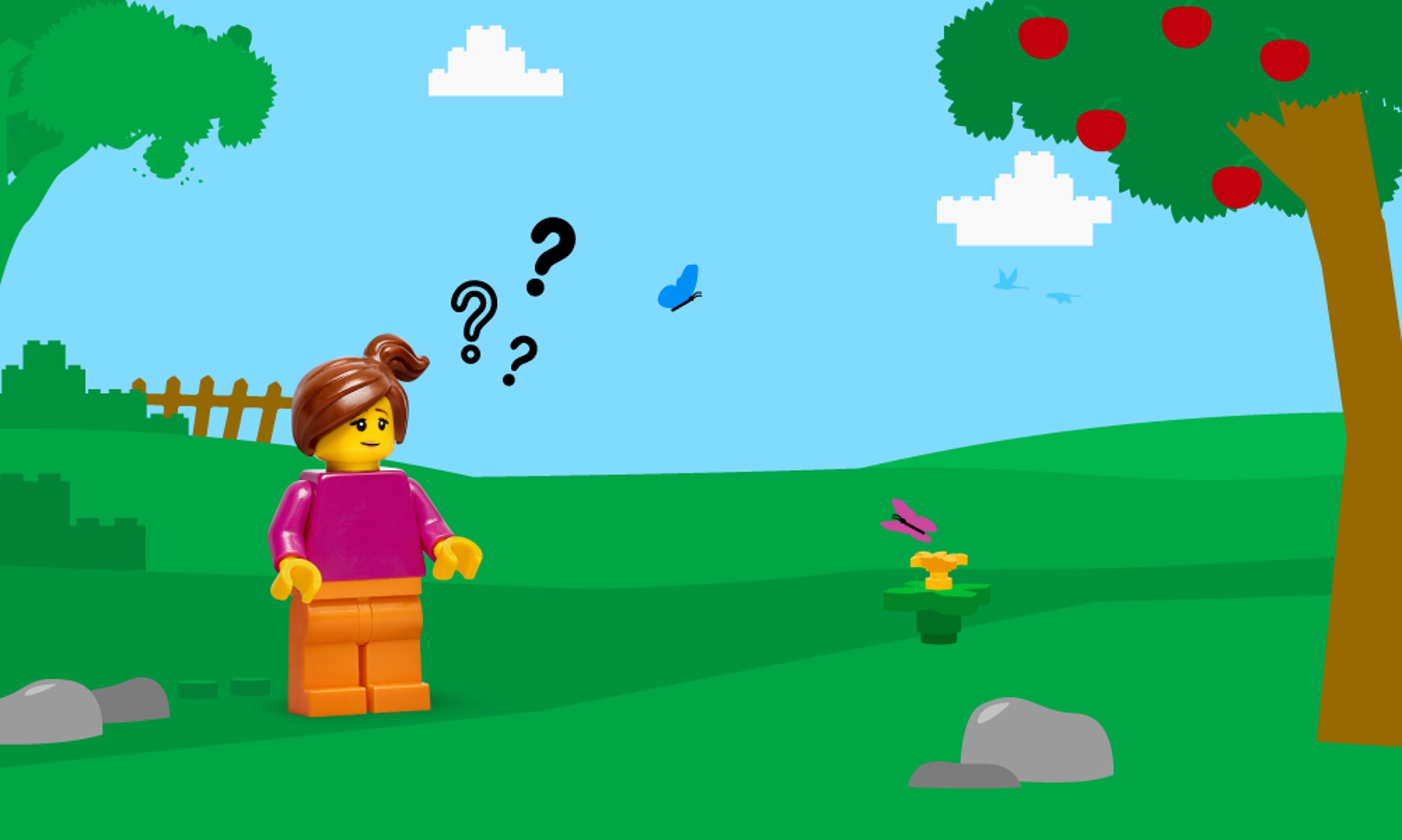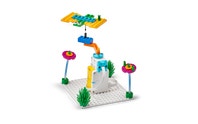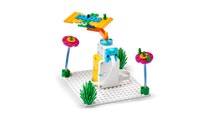Pollination
Maria saw bees on the flowers of her apple tree. She wonders what they’re doing. Can you help her learn?

Prepare
(NOTE: This lesson contains a Part A and a Part B. Both are important to access the full learning of the curriculum. If time is limited, review both parts to choose elements that meet your students’ needs.)
In this lesson, students will build a model that shows how animals move pollen from one plant to another during the pollination process and Elaborate with it to show the seed dispersal process. The example images are provided for inspiration. Encourage students to design and build their own ideas about these processes.
- Build Prior Knowledge - Pollination: Using your core science materials, share information, images and definitions. If possible, reference a labelled diagram of plant parts.
- Plants need pollen from other plants to make seeds that create new plants.
- Animals help transfer pollen from one flowering plant to another in a process called pollination.
- When animals like insects (bees), bats and birds gather nectar from a flower, they brush against the flower’s stamen and pick up pollen. The stamens are arranged to make this easier.
- Key vocabulary: pollen, pollination, dispersal (optional: stamen, pistil)
- Building and Programming Experience: Consider the suggestions in the Unit Plan. For this lesson, you may also want to
- Reinforce with the Motor tutorial in the SPIKE App Start menu.
- Use the Motor and Event Blocks sections of the Help>Icon Blocks menu in the SPIKE app to provide more support.
- Materials: Locate age-appropriate science videos about pollination and a labelled diagram of plant parts. For videos, use the search term pollination (and dispersal if you wish). For diagrams, use the search terms labelled plant diagram year 3 to locate images beyond those in your science curriculum.
PART A (45 Minutes)
Engage
(Whole Class, 10 minutes)

Introduce the story’s main character(s) and the first challenge: Maria saw bees on the flowers of her apple tree. She wonders what they’re doing. Can you help her learn?
THINK – Facilitate a brief discussion about the lesson topic(s), using the story picture if you wish.
- Why do plants need pollen? (Plants need pollen from other plants to make seeds.)
- How does pollen get from one flower to another? (Birds, such as hummingbirds and insects, such as bees and butterflies, pollinate the flowers of many plants. They get the pollen from one flower and leave it on another.)
- How do the parts of a flower make pollination easier? (Flower parts like the stamen make it easier for animals to get the pollen. Parts like the pistil make it easier for animals to put the pollen in a new flower.)
Distribute a SPIKE Essential Set and device to each group.
Explore
(Small Groups, 25 minutes)
As students work, consider sharing the examples below as support for building or programming. Clarify that the image(s) show one idea and students should build their own ideas for how animals move pollen from one plant to another.
Have students:
- Use the base model to BUILD a model to help Maria learn. Show one way that animals move pollen from one plant to another.
- PROGRAM their model to show when or how pollination happens.
Facilitate brainstorming about ways to use LEGO® elements to create pollen that can be transferred from one plant to another by an animal. Guide them toward including a movable piece of pollen.
Halfway through work time, have students exchange ideas using a familiar classroom routine and then update their models with inspiration from sharing.
Example Ideas




Explain
(Whole Class, 10 minutes)
Gather students for sharing.
Have each group use their model to demonstrate and explain:
- Which part of the plant helps put pollen onto an animal? Which part of another plant takes the pollen off?
- Which part of an animal helps move pollen from one plant to another?
- Why are animals important for pollinating plants?
Invite students to share how they changed their model to improve its performance.
If you wish to continue to Part B – Explain, have students keep their models intact or allow time for rebuilding.
PART B (45 minutes)
Explain
(Whole Class, 10 minutes)
- Repeat the steps from Part A - Explain to have additional groups demonstrate and explain their learning.
Elaborate
(Whole Class, 30 minutes)
(5 min) Share background to help students Elaborate:
- After a flower is pollinated, the plant makes fruit that contains seeds.
- Sometimes animals eat the fruit and later leave the seeds in new places as droppings.
- Sometimes seeds are inside prickly burrs that stick onto the body of animals like deer, rabbits or dogs and later fall off in new places.
(20 min) Have your students iterate and test their models to complete the next challenge in the app:
- Design, build and program a model that shows one way that animals can spread seeds.
(5 min) Invite students to share knowledge, ideas or skills that:
- Helped them complete the challenge.
- They learned while building.
Have students clean up the sets and work areas.
Evaluate
(Whole Class, 5 minutes)
- Ask guiding questions to elicit students’ thinking and their decisions while ideating, building and programming.
Observation Checklist
Review the learning objectives (Teacher Support box).
Use the checklist to observe students’ progress:
- Their models of pollination between a plant and animal include a removable pollen piece.
- Their explanation demonstrates that pollen is transferred through physical contact with an animal.
- They explain why animals are important to the pollination process and seed dispersal (Elaborate).
Self-Assessment
Have each student choose the brick that they feel best represents their performance。
- Blue brick: I think I can follow instructions to create a program.
- Yellow brick: I can follow instructions to create a program.
- Green brick: I can follow instructions to create a program and I can help a friend do it too.
Peer Feedback
In their small groups, have your students discuss their experiences working together.
Encourage them to use statements like these:
- I liked it when you…
- I’d like to hear more about how you…
Differentiation
Simplify this lesson by:
- Narrowing the first challenge by assigning students a specific animal (like a bee, bird or bat) to show in their model. Ask students yes/no questions to elicit their explanation.
Increase the difficulty by:
- Extending the Elaborate challenge: Have students change their Elaborate models to show additional ways seeds are dispersed, such as being transported by wind or water.
Extension
- Share that monarch butterflies are important pollinators. Locate a bar graph showing the changes in the population of these pollinators (search images for Monarch population in millions). Have students use the bar graph numbers (without the represented millions) to add and subtract the population of different years. For example, if the bar for 2015 says 42 and the bar for 2014 says 25, what is the difference in population between the two years?
If facilitated, this will extend beyond the 45-minute lesson.
Teacher Support
Students will:
- Explain how animals help plants spread pollen.
- Build an accurate model of the pollination process, with details showing pollen transfer through direct contact with a bird, a bat or an insect.
(one for every two students)
- LEGO® Education SPIKE™ Essential Set
- Device with the LEGO Education SPIKE App installed
- See Prepare - Materials.
ACSSU030 ACTDIK001 ACTDIP004 ACELY1666 ACMNA030 ACMSP049 ACMSP050
Science (Biological Sciences)
Year 2 Living Things Grow, Change, and Have Offspring:
ACSSU030: "Living things grow, change, and have offspring similar to themselves."
Technologies (Design and Technologies)
Years F–2 Exploring and Using Digital Systems:
ACTDIK001: "Recognise and explore digital systems (hardware and software components) for a purpose."
Technologies (Digital Technologies)
Years F–2 Digital Implementation:
ACTDIP004: "Follow, describe and represent a sequence of steps and decisions (algorithms) needed to solve simple problems."
English (Literacy)
Year 2 Speaking and Listening:
ACELY1666: "Listen for specific purposes and information, including instructions, and extend students’ own and others' ideas in discussions."
Mathematics (Number and Operations in Base Ten)
Year 2 Addition and Subtraction:
ACMNA030: "Solve simple addition and subtraction problems using a range of efficient mental and written strategies."
Mathematics (Measurement and Data - Math Extension)
Year 2 Representing and Interpreting Data:
ACMSP049: "Collect, check and classify data."
ACMSP050: "Create displays of data using lists, table and picture graphs and interpret them."




